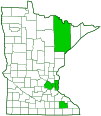wild carrot wasp
(Gasteruption assectator)
Conservation • Description • Habitat • Ecology • Distribution • Taxonomy
Conservation Status |
|
|||||||
| IUCN Red List | not listed |
|||||||
| NatureServe | not listed |
|||||||
| Minnesota | not listed |
|||||||
Description |
||
Wild carrot wasp is widespread and fairly common across North America and Europe. It is a parasite on the nests of bees and wasps that nest in wood or twigs. Adults are ½″ to ¾″ long and mostly black with some reddish-brown markings. The head is black and is clearly separated from the thorax by a long neck. The back of the head is shallowly concave when viewed from above. The top of the head is dull, not shiny, and is covered with scattered, small, indistinct punctures. The mouth parts are brown. The compound eyes are conspicuously covered with dense, short hairs. The antennae are short and thread-like. The female antenna has 14 segments, the male antenna 13 segments. The fourth antennal segment is 2.5 times as long as wide on the male, 2.7 times as long as wide on the male. The thorax is entirely black. The upper front margin of the plate on the first thoracic segment (pronotum) usually has a weak, blunt, forward-projecting tooth. The second thoracic segment (mesonotum), has fine, smooth sculpting and small, indistinct punctures. The lateral lobe is dull, not shiny. It has scattered, fine, indistinct punctures, and is not wrinkled. The small plate covering the wing base (tegula) is black. The abdomen very long, slender, and mostly black. It is attached to the thorax high, far above the bases of the hind legs (coxae). It is very slender at the base, gradually widening as it approaches the tip. The end of the second and third abdominal segments are reddish-brown. On the female, the ovipositor sheath is entirely black and short, a little over one third the length of the forewing. The forewing has a closed cell on the front (costal) margin. In the median area, there is only a single cross vein (recurrent vein) and a single closed medial cell. When at rest, the forewing folds back on itself. The front and middle legs are brown beyond the two black basal segments. The tibiae on the front and middle legs are distinctly pale at the tip. On the hind leg the second basal segment (trochanter) has two segments. The tibia are swollen and have a pale area near the base. The section corresponding to the foot (tarsus) is brown and has five segments. The second segment is long, about 3.7 times as long as wide on the male, 3.0 times as long as wide in the female. |
||
Size |
||
Total length: ½″ to ¾″ |
||
Similar Species |
||
| Gasteruption kirbii is very similar but much rarer. | ||
Habitat |
||
|
||
Ecology |
||
Season |
||
Mid-May through September |
||
Behavior |
||
|
||
Life Cycle |
||
Third stage (instar) larvae overwinter in cocoons. They pupate in the spring and emerge as adults in spring or early summer. |
||
Larva Food |
||
The larva in the cell of the host nest, followed by the food collected for it in that cell. When that is consumed, it may move on to an adjacent cell. |
||
Adult Food |
||
Flower nectar and pollen |
||
Distribution |
||||
|
Sources |
|||
| 12/14/2022 | ||||
Occurrence |
||||
Fairly common |
||||
Taxonomy |
|||
Order |
Hymenoptera (Ants, Bees, Wasps, and Sawflies) | ||
Suborder |
Apocrita (narrow-waisted wasps, ants, and bees) | ||
Superfamily |
Evanioidea (aulacid, carrot, and ensign wasps) | ||
Family |
Gasteruptiidae (carrot wasps) | ||
Subfamily |
Gasteruptiinae | ||
Genus |
Gasteruption | ||
Subordinate Taxa |
|||
wild carrot wasp (Gasteruption assectator assectator) wild carrot wasp (Gasteruption assectator utahensis) |
|||
Synonyms |
|||
|
|||
Common Names |
|||
wild carrot wasp |
|||
Glossary
Instar
The developmental stage of arthropods between each molt; in insects, the developmental stage of the larvae or nymph.
Mesonotum
The principal exoskeletal plate on the upper (dorsal) part of the middle segment of the thorax of an insect.
Pronotum
The exoskeletal plate on the upper side of the first segment of the thorax of an insect.
Tarsus
On insects, the last two to five subdivisions of the leg, attached to the tibia; the foot. On spiders, the last segment of the leg. Plural: tarsi.
Tegula
A small, hardened, plate, scale, or flap-like structure that overlaps the base of the forewing of insects in the orders Lepidoptera, Hymenoptera, Diptera, and Homoptera. Plural: tegulae.
Tibia
The fourth segment of an insect leg, after the femur and before the tarsus (foot). The fifth segment of a spider leg or palp. Plural: tibiae.
Visitor Photos |
|||||
Share your photo of this insect. |
|||||
| This button not working for you? Simply email us at info@MinnesotaSeasons.com. Attach one or more photos and, if you like, a caption. |
|||||
Alfredo Colon |
|||||
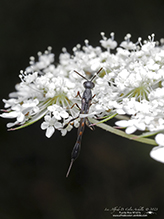 |
|||||
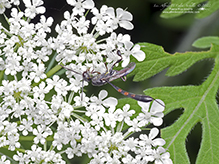 |
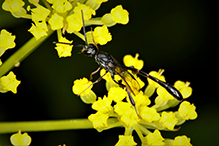 |
||||
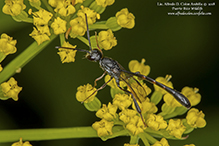 |
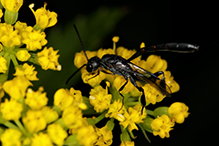 |
||||
MinnesotaSeasons.com Photos |
|||||
|
|||||

Slideshows |
||
| Gasteruptiidae Nikolai Vladimirov |
||
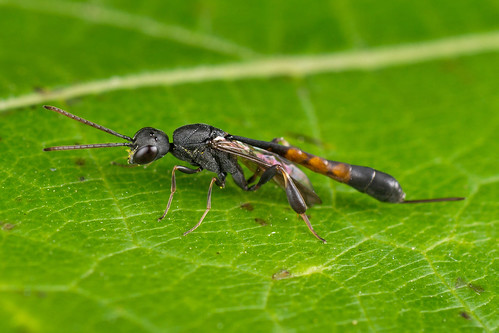
|
||
| Gasteruption assectator ? Petra Karg |
||
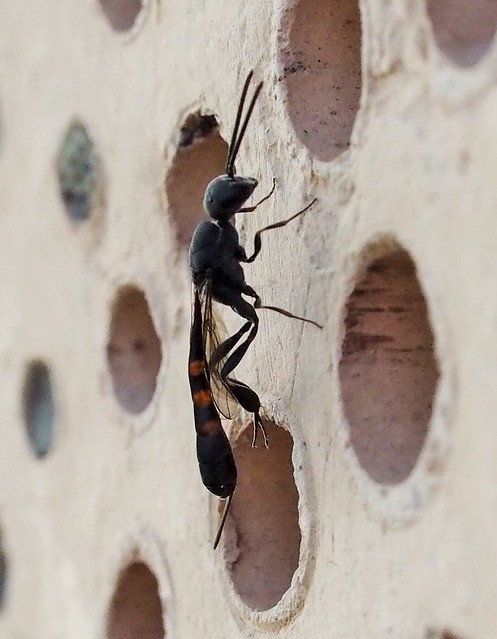
|
||
About
Gichtwespe, Schmarotzer Hylaeus? |
||

Visitor Videos |
|||
Share your video of this insect. |
|||
| This button not working for you? Simply email us at info@MinnesotaSeasons.com. Attach a video, a YouTube link, or a cloud storage link. |
|||
Other Videos |
|||
| Naturbeobachtung Schmalbauchwespe Gasteruption assectator(L. 1758)) Boris Karl Holger Schnebele |
|||
About
Published on Aug 31, 2017 Noch lässt sich "Natur" beobachten - wie lange wohl noch? Jene Art Schmalbauchwespe legt ihre Eier in Nester von Hylaeus-Bienen oder auch Grabwespen(je nach Quellenangaben) ab. Dort frisst sie dann ihre Wirtslarve sowie deren Vorräte auf. Hier besucht sie Blüten des Korianders. http://www.insektenbox.de/hautfl/gastas.htm Google Translation: Still "nature" can be observed - how much longer? The species of beetle wasp lays its eggs in nests of Hylaeus bees or diggers wasps (depending on sources). There she then eats her host larva and their supplies. Here she visits flowers of coriander. |
|||


Last Updated:
